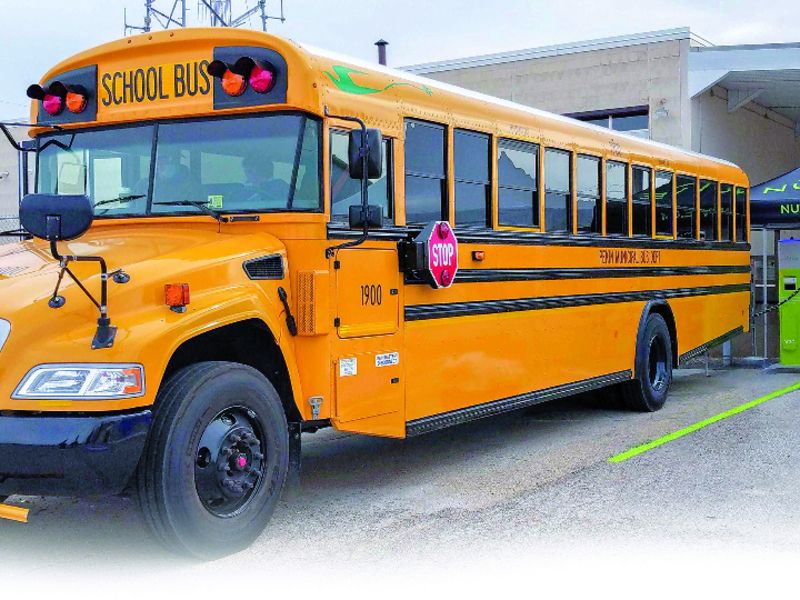
School buses may be America’s most ubiquitous and underappreciated transportation resource. From rural roads to urban centers, more than 10,000 school districts rely upon approximately 480,000 school buses to carry 24 million students twice a day. By comparison, that’s more than eight times the number of domestic air passengers who fly each day.
Someday soon, school buses might serve a second purpose. In addition to transporting students, they may be a nationwide energy source.
“The school bus industry is almost at the tip of the spear when it comes to vehicle-to-grid technology,” says Kevin Matthews, managing director, sustainability sector, for National Strategies, a Washington-based research and consulting firm that works with state and local governments. “The lightbulbs have gone off, especially with utilities, that yeah, we can figure out our vehicle-to-grid issues with school buses.”
Vehicle-to-grid (V2G) technology holds the possibility of transforming electrified buses into mobile power plants that fortify electric grids by offering energy at times of peak demand.
The two make — no pun intended — a powerful tandem. Electrified school buses drive repeatable routes where the required daily range is precisely known. Their schedules are predictable, with morning and midafternoon runs. About 85 percent of the time, Matthews says, the buses are parked, usually at the same depots.
All of this provides plenty of leeway for recharging school buses at off-peak hours and then reselling unused energy back to the grid during times of peak demand. Especially during the summer, when Americans run their air conditioners — often straining energy providers.
National Strategies is working with a project funded by the Department of Energy, in which school bus manufacturer Blue Bird, V2G software and hardware supplier Nuvve Holding Corp., utilities, municipalities and school districts are working to produce 10 vehicle-to-grid-capable school buses by late 2022.
In March, two prototypes equipped with bidirectional charging capability were delivered to school districts in Illinois. Eight more are scheduled to be developed for the Rialto Unified School District in Southern California.
“In California, they’re super interested because they have goals for increasing renewable energy on the grid and they’re looking for ways to store it,” said Mark Trahand, executive vice president of San Diego-based Nuvve. “We cannot do this without storage. It’s just not going to happen. And the cheapest way to provide storage today is using batteries.”
Interest has been piqued for another reason. The $1.2 trillion bipartisan infrastructure framework supported by President Joe Biden allocates $7.5 billion for electric school and transit buses, which would hasten the replacement of diesel buses and help reach environmental goals. In an industry in which fleet turnover occurs every 14 to 16 years, experts believe the White House’s proposal could accelerate that timeline by 20 to 40 percent by 2030.
V2G proponents do not want to miss that ride. Electrifying school buses without allowing for the two-way flow of energy would be akin to investing in pagers at a time when cellphones were on the horizon. Nuvve says V2G is more than on the horizon. The underlying technology has existed for a quarter century. The company launched its first project in Hong Kong in 2012 and started its first commercial service in Denmark in 2016. It now boasts projects on five continents, where its platform can help fleet managers connect and oversee fleets of V2G-enabled vehicles.
The potential is significant: Blue Bird is using 125-kilowatt-hour batteries that provide the grid with direct-current energy, double the 60-kWh batteries used in some other V2G projects. A dozen buses, ostensibly, could offer more than a megawatt of energy — an appealing figure for utility providers.
“When you’ve got big-city districts that have a few thousand buses, that’s a couple of power plants,” Matthews said. “That’s just a lot. They’re concentrated in big cities where demand is an issue. So it really makes a difference.”
Significant hurdles remain. Much like passenger vehicles, electric school buses have a higher initial cost compared with their conventional counterparts. Trahand estimates an EV school bus can cost $300,000, while conventional diesel-powered buses cost half that.
Savings on operations and maintenance can help offset the higher upfront costs. But interconnection agreements between utility providers and distributed system operators are often difficult to negotiate, and charging standards set between equipment providers and engineering bodies are in their infancy.
The Jeff Bezos Earth Fund-backed World Resources Institute has sought to address these issues and promote policies that support adoption of electric school buses.
One possible way to address higher upfront costs, Matthews said, is that municipal utility operators could own fleets that are then leased to school districts. Such an arrangement might significantly decrease peak-demand costs for municipalities, and those savings could be passed along to consumers.
It would be a specific way to cut costs, improve the grid and, perhaps, remind consumers about the overall potential of electric vehicles.
“School buses touch everybody, and that’s why a lot of people, including me, think it can do a lot to advance electrification,” he said. “It’s driving down every neighborhood. Everybody’s kids are getting on it. It’s got a real possibility to not just accelerate vehicle-to-grid [technology] and school bus electrification, but to get a lot of people looking at electric vehicles.”

